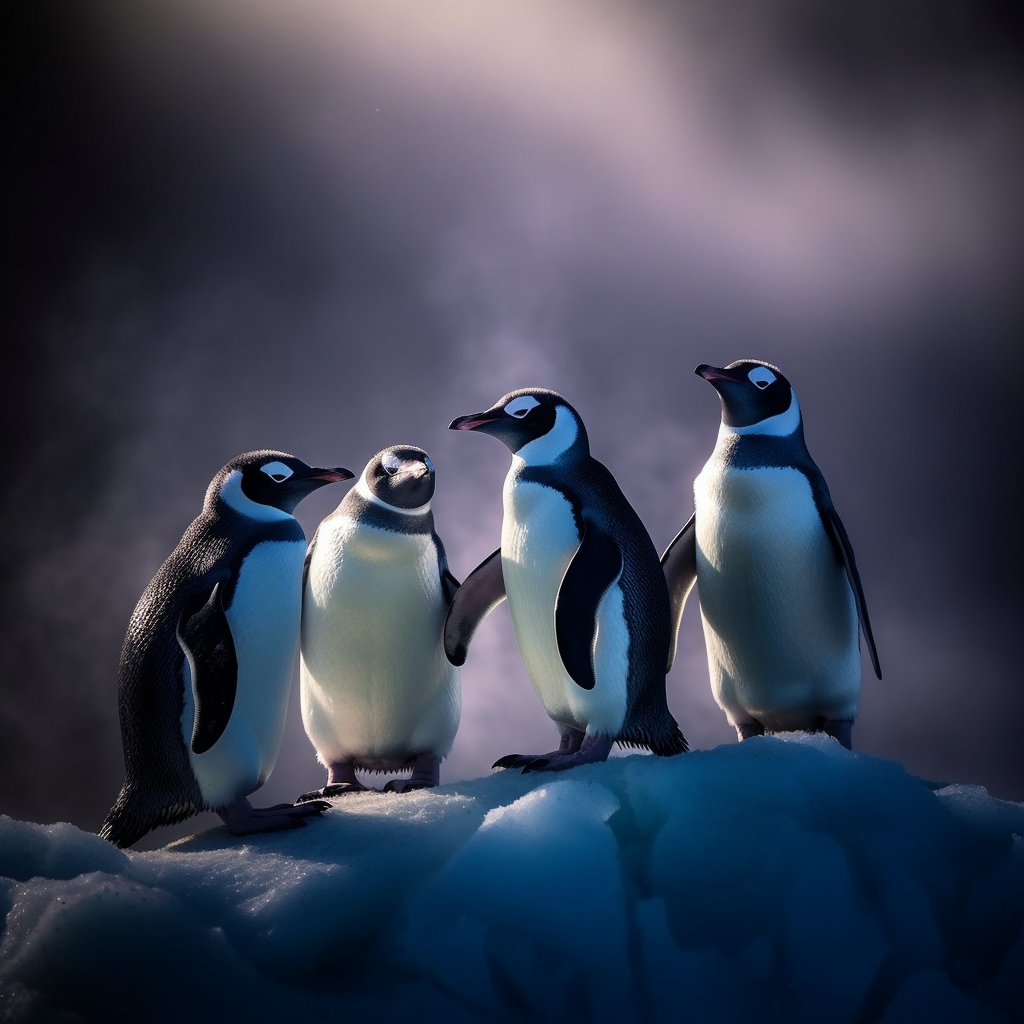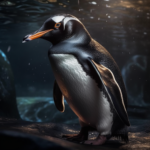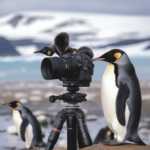Penguins are fascinating creatures that have captured the hearts of many people around the world. Known for their distinctive appearance and adorable waddle, these flightless birds are found in the Southern Hemisphere, particularly in Antarctica. While we often associate penguins with eating fish, there is a common question that arises: do penguins eat plankton? In this article, we will explore the dietary habits of penguins and delve into whether or not plankton is a part of their menu. So, let’s dive into the world of penguins and discover what they really eat!
Key Takeaways
- Penguins primarily feed on fish, squid, and krill, rather than plankton.
- Plankton forms a small part of the diet for some penguin species, especially during breeding seasons.
- Penguins rely on their hunting skills and diving abilities to catch larger prey in the ocean.
- Understanding penguin feeding habits helps in conservation efforts and maintaining their ecosystem.
Understanding Penguins: An Overview
A. The Penguin Diet: A General Perspective
Penguins, those adorable and charismatic creatures, have a diverse diet that varies depending on their species and habitat. While not all penguins eat plankton, it is an essential part of the diet for some species. Let’s take a closer look at what penguins eat and how their diet contributes to their survival in the Antarctic ecosystem.
Penguins are aquatic birds that spend most of their lives in the ocean. They are excellent swimmers and have adapted to thrive in the cold waters of the Southern Hemisphere. As carnivores, penguins primarily feed on marine organisms, including fish, squid, crustaceans, and, in some cases, plankton.
Different species of penguins have different dietary preferences. For example, the Adelie penguin primarily feeds on krill, a small shrimp-like crustacean that forms a significant part of their diet. Krill is abundant in the Southern Ocean and serves as a vital food source for many Antarctic wildlife species.
Other penguin species, such as the Emperor penguin, rely more heavily on fish as their main source of sustenance. These fish-eating penguins hunt for species like Antarctic silverfish and lanternfish, which are found in the icy waters surrounding Antarctica.
B. Why Do Penguins Eat What They Eat?
Penguins’ feeding habits are influenced by various factors, including their physiology, the availability of prey, and the dynamics of the marine food chain. Let’s explore some of the reasons behind their dietary choices.
-
Adaptation to the Environment: Penguins have evolved to survive in harsh and extreme conditions. Their diet reflects their ability to adapt to the limited food sources available in their habitat. By consuming krill and fish, penguins obtain the necessary nutrients to maintain their energy levels and survive in the frigid Antarctic waters.
-
Plankton as a Vital Component: While not all penguins eat plankton, it plays a crucial role in the Antarctic ecosystem. Plankton, consisting of tiny plants (phytoplankton) and animals (zooplankton), forms the base of the ocean food chain. It serves as a primary food source for many marine organisms, including krill. Penguins that feed on krill indirectly rely on the abundance of plankton to sustain their prey population.
-
Foraging Behavior: Penguins exhibit various foraging behaviors to catch their prey. Some species, like the Gentoo penguin, are known for their diving abilities, allowing them to reach deeper depths where fish and squid reside. Others, like the Chinstrap penguin, are skilled at catching krill near the ocean’s surface. These adaptations enable penguins to exploit different food sources and maximize their chances of finding nourishment.
In conclusion, while not all penguins eat plankton, it is an essential part of the diet for some species. Penguins have evolved to thrive in the Antarctic ecosystem, where they rely on a diverse range of marine organisms for sustenance. Understanding their dietary preferences and the factors that influence their feeding habits provides valuable insights into the delicate balance of the ocean ecosystem and the remarkable adaptations of these fascinating seabirds.
Do Penguins Eat Plankton: Unveiling The Truth

A. The Role of Plankton in a Penguin’s Diet
Plankton, the tiny organisms that drift in the ocean currents, play a crucial role in the diet of many marine creatures. Penguins, those charismatic and agile birds that inhabit the icy realms of the Antarctic, are no exception. While penguins are often associated with feasting on fish and krill, their diet also includes various types of plankton.
In the vast ocean ecosystem, plankton serves as a primary food source for many marine organisms, forming the foundation of the food chain. Penguins, being adept hunters, have adapted to exploit this resource to their advantage. They have developed a remarkable ability to forage and feed on different types of plankton, ensuring their survival in the harsh Antarctic environment.
B. Differentiating Between Phytoplankton and Zooplankton
When discussing the role of plankton in a penguin’s diet, it is essential to understand the distinction between two main types of plankton: phytoplankton and zooplankton.
-
Phytoplankton: These are microscopic, plant-like organisms that harness the energy of the sun through photosynthesis. They are the primary producers in the ocean, converting sunlight and nutrients into organic matter. Phytoplankton forms the base of the marine food chain, providing nourishment for zooplankton and other organisms higher up the ladder.
-
Zooplankton: Unlike phytoplankton, zooplankton consists of small, animal-like organisms that consume phytoplankton or other zooplankton. They serve as an intermediate link in the marine food web, transferring energy from phytoplankton to higher trophic levels. Zooplankton includes various organisms such as copepods, krill, and small crustaceans.
Penguins primarily feed on zooplankton, particularly krill, which is a type of small shrimp-like crustacean. Krill is abundant in the Antarctic waters and forms a significant part of the penguin’s diet. These agile birds use their streamlined bodies and strong beaks to capture and consume krill, ensuring they obtain the necessary nutrients for their survival.
While phytoplankton is not a direct food source for penguins, it indirectly influences their diet. As phytoplankton thrives, it provides sustenance for zooplankton populations, which in turn become prey for penguins. Thus, the health and abundance of phytoplankton have a cascading effect on the entire Antarctic ecosystem, including the penguins’ feeding habits.
In conclusion, penguins do consume plankton as part of their diet. While they primarily target zooplankton, such as krill, the presence and abundance of phytoplankton indirectly support the penguin’s food chain. Understanding the intricate relationship between penguins and plankton sheds light on the delicate balance within the Antarctic ecosystem and the remarkable adaptations of these fascinating aquatic birds.
The Algae Factor: Do Penguins Consume Algae?

A. Exploring the Algae Consumption in Different Penguin Species
When we think of penguins, we often imagine them diving into the icy waters of the Antarctic in search of fish or krill. However, these fascinating creatures have a more diverse diet than we might expect. While it is true that the primary food source for most penguin species is fish and krill, some penguins also consume algae as part of their diet.
Algae, a type of plant-like organism that grows in water, plays a crucial role in the ocean ecosystem. It serves as a primary producer, converting sunlight into energy through photosynthesis. This makes it an essential food source for many marine organisms, including some penguin species.
Among the various penguin species, the Gentoo penguin is known to consume algae. These penguins inhabit the sub-Antarctic islands and the Antarctic Peninsula, where they have access to a wide range of food sources. While fish and krill make up the majority of their diet, Gentoo penguins also supplement their meals with algae. They primarily feed on diatoms, a type of algae that forms the basis of the Antarctic food chain.
B. Does Penguin’s Diet Include Seaweed?
Seaweed, another type of algae, is not a significant part of a penguin’s diet. Unlike Gentoo penguins, most penguin species do not consume seaweed regularly. Seaweed tends to grow in shallow coastal waters, which are not typically the preferred foraging grounds for penguins.
Penguins are well-adapted to hunting in the open ocean, where they can dive deep to catch fish and krill. They have streamlined bodies and strong flippers that allow them to swim swiftly and efficiently. While they may encounter seaweed during their foraging expeditions, it is not a primary food source for them.
It is worth noting that the consumption of algae by penguins is not as prevalent as their consumption of fish and krill. Penguins have evolved to be efficient hunters in the marine environment, focusing on prey that provides them with the necessary nutrients and energy. Algae, although consumed by some penguin species, does not make up a significant portion of their diet.
In conclusion, while penguins are primarily known for their consumption of fish and krill, some species, such as the Gentoo penguin, also incorporate algae into their diet. However, seaweed is not a significant part of a penguin’s diet. These fascinating aquatic birds have adapted to thrive in their unique environment, utilizing the resources available to them in the Antarctic ecosystem.
The Emperor Penguin: A Special Case

A. Do Emperor Penguins Eat Plankton?
When it comes to the diet of penguins, the Emperor Penguin is a fascinating case. These majestic creatures are known for their resilience and adaptability in the harsh Antarctic environment. While many penguin species primarily feed on fish and krill, the Emperor Penguin has a unique dietary preference.
Contrary to popular belief, Emperor Penguins do not rely heavily on plankton as a food source. Instead, they primarily feed on fish and squid, which they catch by diving deep into the frigid waters of the Southern Ocean. These agile birds can dive to impressive depths, reaching up to 500 meters (1,640 feet) in search of their prey.
B. The Unique Dietary Habits of Emperor Penguins
Emperor Penguins have a varied diet that consists mainly of fish and squid. They are opportunistic feeders, meaning they will consume whatever prey is abundant and readily available. While they may occasionally consume small amounts of plankton, it is not a significant part of their diet.
The reason behind this dietary difference lies in the Emperor Penguin‘s foraging behavior. Unlike other penguin species that rely on surface feeding or shallow dives to catch their prey, Emperor Penguins are skilled deep divers. This allows them to access a wider range of food sources, including larger fish and squid that inhabit the deeper parts of the ocean.
By diving to such depths, Emperor Penguins can bypass the plankton-rich surface waters and target larger prey items. This unique feeding strategy sets them apart from other penguin species and showcases their remarkable adaptability to the Antarctic ecosystem.
To better understand the dietary preferences of Emperor Penguins, researchers have conducted studies to analyze the stomach contents of these birds. These studies have consistently shown that fish and squid make up the majority of their diet, with plankton playing a minor role, if any.
In conclusion, while some penguin species do consume plankton as a significant part of their diet, Emperor Penguins have a different approach. Their deep diving abilities allow them to target larger prey items, such as fish and squid, making plankton a less prominent part of their diet. This unique feeding behavior showcases the adaptability and resourcefulness of these incredible birds in the challenging Antarctic environment.
Beyond Plankton and Algae: What Else Do Penguins Eat?
A. Do Penguins Eat Bugs?
While plankton and algae make up a significant portion of a penguin’s diet, these adorable aquatic birds also consume a variety of other foods to meet their nutritional needs. One such food source includes bugs. Although bugs may not be the primary component of a penguin’s diet, they do play a role in their overall feeding habits.
Penguins often encounter bugs, such as flies and beetles, during their foraging expeditions. These insects are attracted to the nutrient-rich areas where penguins gather, such as penguin rookeries or colonies. While bugs may not be as abundant as plankton or krill, penguins opportunistically feed on them when the opportunity arises.
It’s important to note that bugs are not a staple food for penguins. They primarily rely on marine organisms like krill, fish, and squid for sustenance. However, the occasional consumption of bugs provides penguins with additional nutrients and variety in their diet.
B. Foods Penguins Avoid: What Do Penguins Not Like to Eat?
While penguins have a diverse diet, there are certain foods they tend to avoid. These preferences can vary among different penguin species and their respective habitats. Here are some examples of foods that penguins generally do not like to eat:
-
Seaweed and Seagrass: Penguins are not well-equipped to digest plant matter, including seaweed and seagrass. Their digestive systems are more suited to process animal-based foods, making them less inclined to consume plant material.
-
Large Fish: Penguins typically feed on smaller fish species that are easier to catch and swallow. Larger fish, such as sharks or tuna, are not part of their regular diet due to their size and potential difficulty in capturing them.
-
Land Animals: Penguins are adapted to thrive in the marine environment and are not designed to hunt or consume land animals. They primarily rely on the rich resources found in the ocean ecosystem for their sustenance.
-
Inedible Marine Organisms: Penguins have evolved to selectively target specific prey items that provide them with the necessary nutrients. They tend to avoid consuming inedible marine organisms that may not offer sufficient nutritional value.
By understanding what penguins do not like to eat, we gain insight into their feeding habits and preferences. This knowledge helps us appreciate the specialized nature of their diet and the unique role they play in the Antarctic ecosystem.
In conclusion, while plankton and algae form a significant part of a penguin’s diet, they also consume bugs opportunistically. On the other hand, penguins tend to avoid foods like seaweed, seagrass, large fish, land animals, and inedible marine organisms. By maintaining a balanced and varied diet, penguins can thrive in their icy habitats and continue to captivate us with their adorable waddles and remarkable survival skills. Conclusion
In conclusion, while penguins are known for their love of fish, it is not common for them to eat plankton. These fascinating creatures have adapted to survive in some of the harshest environments on Earth, and their diet reflects this. Penguins primarily feed on fish, squid, and krill, which provide them with the necessary nutrients and energy to thrive. However, there are some exceptions to this general rule. Certain species of penguins, such as the Adelie penguin, have been observed consuming small amounts of plankton when fish and krill are scarce. Nonetheless, plankton does not form a significant part of their diet. Penguins are truly remarkable animals, and their feeding habits play a crucial role in their survival and the delicate balance of the Antarctic ecosystem. So, while plankton may not be a staple food for penguins, it remains an essential source of sustenance for many other marine organisms.
Frequently Asked Questions
1. Do penguins eat algae?
No, penguins do not typically eat algae. They primarily feed on krill, fish, and squid. However, they may indirectly consume algae by eating prey that feeds on it.
2. Do penguins eat phytoplankton?
Penguins do not eat phytoplankton directly. They are carnivorous and their diet mainly consists of krill, fish, and squid. Phytoplankton is a primary food source for krill, which penguins eat in large quantities.
3. Do Galapagos penguins eat algae?
No, Galapagos penguins do not eat algae. They primarily feed on small fish and crustaceans. Algae forms a part of the marine food chain, but it’s not a direct part of the Galapagos penguins‘ diet.
4. Do emperor penguins eat plankton?
Emperor penguins primarily feed on fish, squid, and krill. While plankton is a significant part of the Antarctic ecosystem, it’s not a primary food source for Emperor penguins.
5. Do penguins eat bugs?
Some penguin species, like the African penguin, may occasionally eat insects, but it’s not a significant part of their diet. Penguins primarily feed on aquatic prey like fish, squid, and krill.
6. Why do penguins eat?
Like all animals, penguins eat to gain energy and nutrients necessary for survival, growth, and reproduction. Their diet of fish, squid, and krill provides them with the necessary proteins and fats.
7. Do penguins eat plankton?
While some types of penguins may occasionally consume small amounts of plankton, it’s not a primary food source for them. Penguins are primarily carnivorous and feed on krill, fish, and squid.
8. Do penguins eat seaweed?
No, penguins do not eat seaweed. They are carnivorous birds that feed on krill, fish, and squid. Seaweed is not a part of their diet.
9. Do penguins eat zooplankton?
Yes, some penguin species do eat zooplankton, particularly krill, which is a type of zooplankton. Krill is a significant part of the diet for many penguin species.
10. What do penguins not like to eat?
Penguins are carnivorous and prefer a diet of krill, fish, and squid. They tend not to eat non-aquatic food items like fruits, vegetables, or terrestrial animals. They also do not consume algae or seaweed directly.




